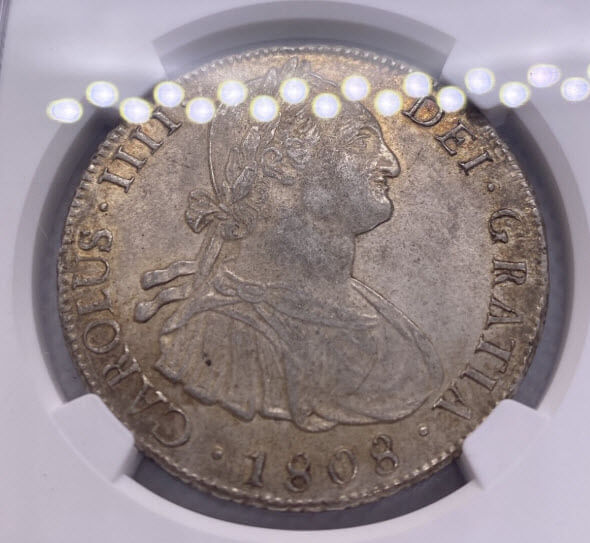1808 PTS PJ Bolivia 8 Reales Silver Coin – Colonial-Era Spanish Treasure from Potosi Mint

The 1808 PTS PJ Bolivia 8 Reales Silver Coin stands as a tangible link to the height of Spanish colonial power in South America. Struck at the famed Potosí Mint in what is now Bolivia, this iconic silver coin not only served as currency but also as a symbol of global trade, political dominance, and cultural influence. It remains one of the most recognizable and collectible numismatic relics of the colonial era.
The 8 Reales denomination — commonly known as the “Piece of Eight” — played an essential role in shaping global commerce during the 18th and early 19th centuries. Coins like this circulated widely across Europe, Asia, the Americas, and even parts of Africa. In 1808, as revolutions simmered throughout Spanish America, this coin was a silent witness to a crumbling empire. The coin’s large size, silver purity, and intricate design make it an enduring artifact of imperial power.
🔗 Explore the 1808 Bolivia 8 Reales Coin
A Coin Minted in the Shadow of Change
The year 1808 was pivotal for the Spanish world. Napoleon had forced King Charles IV to abdicate, installing his brother Joseph Bonaparte as the monarch. Spanish colonies, unsure of their loyalties, found themselves at a political crossroads. Coins minted that year — such as this 8 Reales — bear the name and likeness of Ferdinand VII, the rightful king in the eyes of loyalists. But within years, independence movements would ignite throughout South America, including Bolivia.
This coin serves as a last echo of colonial stability before the revolutionary storm. It was used not just by merchants and traders, but also passed through the hands of revolutionaries, settlers, and soldiers navigating an era of upheaval.
From the Famous Potosí Mint
Founded in 1574, the Potosí Mint (indicated by the “PTS” mintmark) was one of the richest and most productive mints in the Spanish Empire. Located near the famed Cerro Rico silver mountain, it became synonymous with wealth and exploitation. Billions of reales were struck here, and the city’s silver fueled European economies for centuries.
The “PJ” assayer initials on the coin refer to the mint officials responsible for certifying its metal content and quality. Their initials confirmed that the coin met the strict standards of weight and purity — critical for international trust in Spanish coinage.
Coin Specifications
- Date: 1808
- Mint: Potosí (PTS)
- Assayers: PJ
- Denomination: 8 Reales
- Composition: .903 Fine Silver
- Weight: Approx. 27 grams
- Diameter: 38–40 mm
- Obverse: Bust of King Ferdinand VII with legend
- Reverse: Crowned shield of Spain between Pillars of Hercules
- Edge: Milled
Its consistent quality made it a preferred coin in trade, especially in China, the United States, and across Latin America.
Design and Symbolism
The obverse features King Ferdinand VII facing right, crowned and draped in traditional royal attire. The inscription includes his title and the year of minting — a bold political statement in a year where his authority was both challenged and defended across the Spanish world.
The reverse contains the Spanish royal coat of arms, including the lions of León, castles of Castile, and the Bourbon fleur-de-lis — all under a royal crown. Flanking the coat of arms are the famed Pillars of Hercules with banners reading “PLUS ULTRA” (More Beyond), representing Spain’s global reach.
Why the 8 Reales Was a Global Standard
During the colonial period, the Spanish 8 Reales became the first truly global currency. Here’s why:
- ✅ Accepted across continents and cultures
- ✅ Trusted for consistent silver purity
- ✅ Officially legal tender in the U.S. until 1857
- ✅ Chop-marked and circulated heavily in East Asia
- ✅ Frequently imitated by other nations
Coins like this were essential in the silver-for-goods trade with China and powered the trans-Pacific Manila Galleon route, connecting Latin America to Asia.
A Collector’s Favorite
Collectors prize the 1808 Bolivia 8 Reales coin for several reasons:
- ✅ Historically important year amid imperial collapse
- ✅ Produced at the legendary Potosí Mint
- ✅ Intricate colonial-era design elements
- ✅ Wide global influence and circulation
- ✅ Highly collectible due to its association with Ferdinand VII
Graded examples authenticated by services like NGC, PCGS, or ANACS offer added assurance of authenticity and preservation. Even circulated examples are considered numismatically significant.
Comparative Table
| Coin | Year | Mint | Purity | Historical Context |
|---|---|---|---|---|
| 1808 PTS PJ 8 Reales | 1808 | Potosí | .903 | Pre-independence Spanish America |
| 1808 Mo TH 8 Reales | 1808 | Mexico | .903 | Struck under political uncertainty |
| 1810 Lima JP 8 Reales | 1810 | Lima | .903 | Early revolutionary stirrings |
This comparison places the Potosí coin within a broader narrative of Spanish American silver production during colonial collapse.
Museum-Grade Value for Educators and Historians
Beyond collectors, this coin is extremely useful for:
- 📚 Teaching colonial Latin American history
- 🏛 Museum exhibitions on silver trade and empire
- 🔍 Numismatic analysis of mint standards
- 🧭 Understanding economic links between continents
Its global relevance and historical weight make it ideal for contextual storytelling.
The End of an Empire in Your Hand
The 1808 Bolivia 8 Reales isn’t just metal — it’s memory. It’s a coin that represents the wealth of empires, the oppression of colonies, and the dawn of liberation. Each detail — from the royal bust to the mintmark — tells a layered story of identity, resistance, and transformation.
This is why the 8 Reales has endured not just as a trade coin, but as a cultural symbol. It represents a specific moment in time, one filled with tension and transition. It’s a relic of Spain’s once-global reach and the birth of new nations that would soon emerge from its shadow.
🔗 View the 1808 Bolivia 8 Reales Coin
